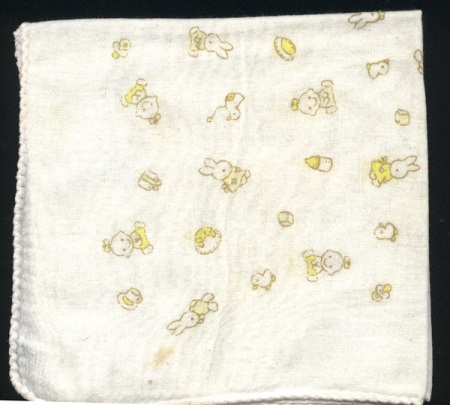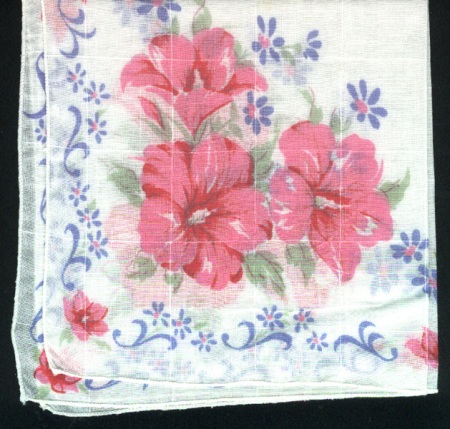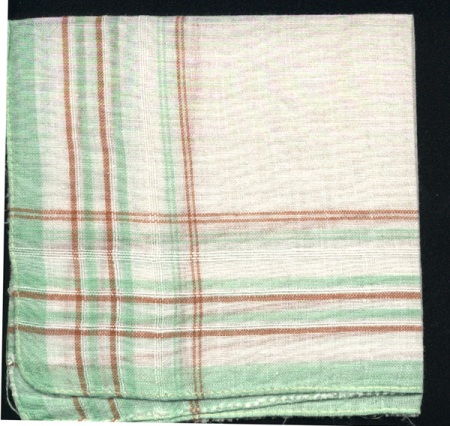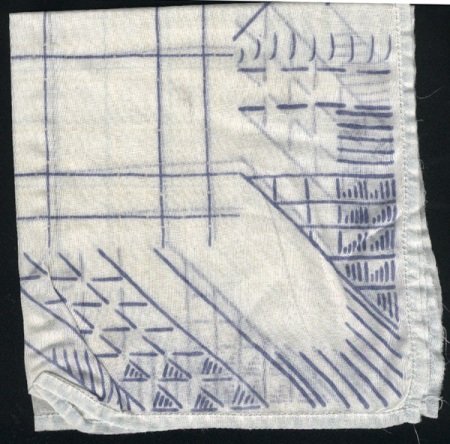“Have you got your lunch? Have you got a handkerchief? Have you got your bus fare?”
The litany repeated every morning when I left for school, then later, when I went out to work. As if I could forget!
“Yes, Mom.” The reply was a “stop-nagging” whine.
It changed on Sundays. “Have you got your handkerchief? Do you have some money for collection?” Always, a nice girl would need a handkerchief. One did not touch one’s face. Or at least, we were not supposed to, but I was always getting chided for this sin of commission. And of course, if you had sniffles….
I brought the shoe box up to my nose. It was full of handkerchiefs and there were a few head scarves as well. It had an old smell, not musty, but of face powder and bath salts that women seldom use these days.
I noticed one day that my friend Geraldine carried cloth hankerchiefs and remarked on it.
“One day, I’ll come across the box of Mom’s handkerchiefs and I’ll give them to you,” I promised. “I don’t use them, myself. I picked up a lot of them for her at the Lutheran Church at their Christmas and Easter sales. It’s amazing how many brand new handkerchiefs I could pick up there, for less than a quarter a piece. After a few years, the lady who ran the thrift table saved them for me. ”
“People brought them back to Mother, too, as presents – from Switzerland, from Germany, from England.”
“My box runneth over with handkerchiefs, ” I mused.
And here was the box with wrinkled and mussy handkerchiefs still smelling of Mom and her toiletries.
Just as mother was reaching her teenage years, Kleenex made its debut in 1924, designed as a facial tissue made of “Cellucotton” to wipe cold cream or make-up from one’s face. But it was The Depression and resources were scare. A cloth hankie could be used over and over again, but a tissue could be used but once.
I left the sixty-plus handkerchiefs to soak in a basin of hot water laced with a delicate-fabric soap and came back to rinse them and dry them a few hours later. In a futile attempt to save time, I did not take them to the basement and the automatic clothes dryer, but began to stretch them, as Mother used to do, flat on the bathroom counter, but I quickly ran out or space and began to hang them out on the towel racks, along the edge of the laundry basket and all along the bathtub rim, and I was only half way through.
Later in the afternoon, I came back to do the other half and take the dry ones to iron.
As I pressed the first one, a light translucent cotton printed with a gay pattern of red and blue flowers, it came to mind that I must have learned to iron on these practical little squares of cloth, something that a child of seven could not ruin easily in her first domestic ironings.
As I continued on the task, I became conscious that I only had six matching handkerchief. Every other one was different.
Of the older types, there were ones with cut work lace (above) and embroidery (below),
with tatted edges or ones with crochet
The needle work is often hand-done with a finesse that is rarely seen today and the fabrics are so sheer, sometimes, that I marvel at the delicacy of it. How do they spin the cotton so fine so that the fiber is strong enough not to break in the weaving process and yet so small in diameter that the fabric is almost see-through.
 There are plain ones and flocked ones, there are silk ones brought from China by some thankful student;
There are plain ones and flocked ones, there are silk ones brought from China by some thankful student;
there are ones with crocheted edges in variegated colour;
There are ones made especially for Christmas,
Some are geometric, or striped – regular horn-blowers for days of groggy flu or sinus numbing colds,
and some have curious, modern calligraphy upon them.
And this nest one was her favorite. It was the kind a flirtatious woman could drop on the floor and her eager swain would stoop to rescue.
Father passed away in 1983.
One day when I was visiting, before I came to live with her, to care for her, we had a cup of tea in the afternoon and she was being coy. Something was on her mind that she wanted to say but she wasn’t sure what my reaction would be, I discovered later.
Finally, she told me she had received a letter from one of Dad’s and her university acquaintances whom they had kept in touch with all their lives. He was an prominent Engineer – a brilliant man, she assured me.
“I can’t read his writing any more,” she said. “Would you read it for me?”
I struggled with the chicken scratchings that marked the page.
“Mom, this isn’t writing. It’s code. It’s unreadable!”
I was teasing her. There were occasional words that were recognizable. With a bit of effort, the entirety could be decoded. I read it to her haltingly as I deciphered it.
“He’ll be here on the twenty-fourth. He’s asking you to have dinner with him.”
I suspected that she already knew, that she had already read the letter and knew its contents.
She had an expression on her face that made me think of a wary animal waiting, not knowing if she were to be caressed or smacked.Timid. Unsure.
“That’s fabulous, Mom!” I said. “How exciting! You do want to go, don’t you?”
“Yes, but what will you children think. Do you think I am being disloyal to your father?”
“Heavens, no! For Pete’s sake, Mom. Dad would want you to be happy. He would want you to enjoy your long term friendships still. I don’t think he want’s you to be a nun and cloister yourself away.”
Now I knew why she was being shy and coy! She was over eighty, but she was thinking of him as a suitor, a beau, a potential boyfriend.
On the twenty-fourth, I was summoned to get her to the hair dresser, then to help her dress. I brushed her clothes to ensure there was not a hair out of place, nor an escapee dangler left on her shoulders. I polished her favorite necklace – a Haida silver man-in-the-moon pendant.
She sat at her dresser, her sterling brush set sitting before her, as she trimmed her nails and put on polish, then selected a bracelet to go with the pendant. I put it on for her and secured the latch of it. She selected a perfume and dabbed it behind her ears.
She powdered her cheeks and brushed on rouge then wiped it away gently with a paper tissue. Nervously, she fingered the little cut crystal pots with silver lids that were her pride and joy – her symbols of ladyship – and moved them, reorganized them, tidied them.
She leaned into the mirror, puckered her lips and carefully drew over her lips with a strong red lipstick.
Into her evening bag, she slipped into it a twenty dollar bill, her lipstick, a compact with rouge, her driver’s license (though she no longer drove), a comb and a nail file.
“Do I look OK?” she asked when she was all done. She was unsure. Excited. Like for a first date.
“You look wonderful, Mom,” I assured her. “There’s not a thing out of place. You look beautiful!”
“Have you got a handkerchief?” I asked. She hadn’t. It was the last thing to do.
She opened the top drawer beside her, pulled out a wad ironed handkerchiefs and picked out this one, her very best, with hand-made Belgian lace and a ruffle on each corner. Soft and refined. The kind one could drop, for a suitor to pick up and admire. And she tucked it into her sleeve.
It’s threadbare now, but that doesn’t matter. I think I will keep this one, in memory.









